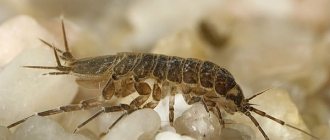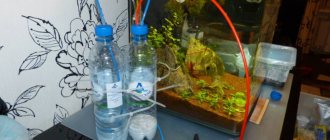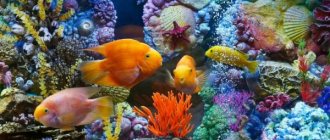Home/AQUARIUM CARE/How to disinfect an aquarium: the most famous methods
How to disinfect an aquarium so as not to harm representatives of flora and fauna ? The need for such measures arises both with prolonged use and with the detection of infections and pathogens. The condition of pets and vegetation depends on the correct implementation of these measures.
In what cases is disinfection necessary?
Disinfection of an aquarium is carried out in two cases:
- During the initial launch of a new artificial reservoir.
- Disinfection of an existing reservoir with disinfectants when infectious diseases are detected.
When starting up the tank for the first time, disinfection is necessary in order to destroy possible contaminants, bacteria, microbes and other viruses, which can subsequently lead to dire consequences and even the death of pets, so it is necessary to treat the aquarium immediately after purchase. An existing aquarium is disinfected if contagious fish diseases or harmful algae have been identified, for example, with ichthyphothyrius, blackbeard or blue-green algae. In these cases, disinfecting the aquarium will not only destroy the remains of bacteria and viruses, but will also help the owner treat their pets.
Disinfection with potassium permanganate and whiteness
The most accessible means for disinfection are a solution of potassium permanganate and whiteness. Almost everyone has them at home, they are relatively safe and accessible. Potassium permanganate and whiteness destroy almost all types of bacteria, microbes and parasites.
Potassium permangantsovka
To treat the tank, a 0.1 percent solution of potassium permanganate is required. It should not be transparent, rather dark. Potassium permanganate is safer than white; it is easily washed off with running water, leaving no traces. But the disinfecting properties of the potassium permanganate solution are quite weak, so for complete disinfection it is necessary to keep the solution in the tank for at least 3-4 days. Potassium permanganate can be used to treat soil, decor, and stones. It leaves no odor or traces.
White
Bleach or bleach perfectly kills all bacteria and germs. To treat the tank, use a 5 percent white solution. Bleach has strong disinfectant properties, so you don’t have to keep it in the tank for a long time. It is enough to leave the solution for a day to kill all microorganisms. Plastic should not be treated with bleach, as it will absorb a pungent odor. To get rid of the smell, you will have to try hard. It is practically not removed from plastic, but drying it in the open air for two days can help. After treatment, the tank is thoroughly washed, including all rubber bands and corners, since the caustic solution is difficult to wash off the first time.
You can disinfect an aquarium with simple hydrogen peroxide. But the peroxide solution does not have pronounced bactericidal properties, so you will have to fill the tank for a long time. In some cases, the peroxide is kept in the tank for about two weeks. Peroxide is the safest method of disinfection.
Primary disinfection of the aquarium
Primary disinfection of the aquarium is carried out before planting plants and laying out soil in order to protect vegetation and fish from possible infections that get inside the tank upon purchase. It is necessary to treat not only the container, but also the soil, as well as the stones for the aquarium. Disinfection of the plant before planting is also required. The primary disinfection procedure can be easily performed at home and will take 72 hours.
To disinfect a pond with potassium permanganate, you must perform the following steps:
- The container is filled with ordinary tap water.
- Prepare a solution by mixing water with potassium permanganate until the liquid acquires a dark tint.
- The solution is poured into the tank and left for a day.
- After a day, all the liquid from the container is drained, the container is rinsed and wiped dry with a clean cloth.
- The procedure is repeated two more times.
Restarting the aquarium: possible reasons
What is the difference between starting an aquarium and restarting it? Yes, practically nothing, only when the aqua system is restarted, it first undergoes full maintenance - cleaning and disinfection (if necessary) of both the can itself and its internal contents.
First of all, it should be noted that there is no set frequency for restarting aquariums.
There is an opinion that this operation must be performed periodically, regardless of the state of the functioning aquarium. Some owners of ornamental fish believe that their homes need to be thoroughly cleaned from time to time, removing dirt and debris.
Opponents of this point of view believe that the aquarium, if you follow all the necessary rules for keeping fish and plants, should function without stopping and restarting, and its restart should be done only in exceptional, urgent cases.
Soil and plant treatment
Successful cultivation of plants in a pond depends on the quality of the soil, so before laying out the substrate must undergo a disinfection period. To process, it is necessary to thoroughly rinse the soil, let it dry and calcine the substrate in an oven for 15 minutes at a temperature of 100°C. The finished soil is allowed to cool at room temperature and placed in a tank.
New plants are disinfected in a weak solution of potassium permanganate, putting aquatic flowers there for 15–20 minutes. The main thing is not to overdo it with potassium permanganate, otherwise there is a risk of burning the tender leaves.
Restarting the aquarium after fish diseases
If the aquarium inhabitants begin to actively die, it means that they need to be rescued and restarted. To begin with, it is worth catching all the sick fish and transplanting them into a quarantine container until they fully recover. It should be filled with warm, settled water.
Next, you need to determine what diseases the fish had. If they are infectious, then you should get rid of the old liquid, and in case of manifestations of diseases caused by parasites, the water can be further used.
It is important that after removing sick pets from the water, the liquid is able to recover on its own, and the parasites living in it soon die.
With such a restart, there is no need to rush. You need to keep your home pond empty of inhabitants for about 2 weeks, clean the filtering equipment and connect all the necessary equipment. During this period, you can change the fluid in a ratio of 35-80% of the norm, and with a temperature of 25 ℃.
During this time, the fish affected by the disease will recover and can be introduced into the aquarium.
Scenery processing
Decorations made of wood, stone or metal, and stones for the aquarium are disinfected by boiling in boiling water for 15–20 minutes - this time is enough to destroy possible harmful bacteria and viruses that can harm the fish. Decorative elements made of plastic cannot be boiled, so a solution of potassium permanganate is used for bactericidal treatment.
Restart instructions
Restarting an aquarium is a long undertaking that every aquarist should be prepared for. It consists of many steps, none of which should be skipped:
First you need to remove all the inhabitants from the aquarium. The fish are transplanted into special small containers of several individuals. Water can be added to the fish tanks from the aquarium, but only if the reason for the restart was not a change in its parameters. If the medium turns out to be spoiled or unsafe, the fish are placed in settled tap water (it is recommended to keep it for 2-3 days to reduce hardness). Next, a filter, heater and lighting are installed in temporary housing. The main task for this period is to completely recreate normal living conditions for each individual.
Aquarium plants must also be removed from the pond. This must be done with special care so as not to damage the root system. Representatives of the flora are also placed in nurseries with water parameters as close as possible.
Next, all decorative items are removed from the pond. They need to be washed with a stiff brush in a soda solution, then rinsed under running water, treated with a disinfectant solution (for example, chlorheskidine or hydrogen peroxide) and rinsed again. The decorations are then left to dry.
After this, you need to treat the soil. It is completely removed from the aquarium and washed under running water. Next, the washed soil is placed in the oven and calcined at a temperature of 200°C for 30 minutes for precise disinfection.
Once the tank is completely empty, you need to clean it thoroughly. The empty container is washed with a solution of soda in warm water. It can be replaced with special detergents. But it is important to purchase them only from pet stores, because ordinary household solutions contain a large amount of chemicals. It is advisable to use a soft sponge, which will not leave scratches on the glass, but will effectively clean them.
If the reason for updating the aquarium was due to problems in the design of the aquarium, then it should be carefully inspected for leaks or cracks. If repairs are necessary, be sure to use only special aquarium sealants.
The restart process ends with the repopulation of the aquarium and the restoration of its previous ecosystem. To do this you need:
- Prepare water within 2-3 days.
- Place washed and dried soil on the bottom.
- Fill it 20-30 cm with settled water.
- Place the plants in the substrate.
- Set up decorations and connect equipment.
- Fill the rest of the tank with water.
- Conduct tests on the quality of the environment, and, if the norm for all indicators is determined, release the fish into the reservoir.
- If at least one water parameter deviates from the norm, then it must be adjusted.
After the restart, it is important to pay close attention to the behavior and well-being of not only fish, but also plants for the first 7-10 days. It is during this period that their body gets used to new living conditions and, at the slightest problem, signals about failures.
Disinfection of an existing aquarium
An existing artificial pond with fish is treated with antibacterial substances. To make the tank disinfected, a solution with penicillin (10 mg/2 l) is used, and the procedure itself takes 72 hours. There is no need to worry about the flora: aquarium plants will not die. If the fish suddenly died in the tank, the treatment is carried out using a bactericidal lamp, turning on the device for 15 minutes for three days in a row.
What could be the reasons for restarting an aquarium with fish?
Firstly , it is carried out if the water is very cloudy, the walls are overgrown with algae, and filtration and volume changes do not have a positive effect on the situation.
Secondly , in case of severe acidification of the soil, if its cleaning or replacement is impossible under continuous operation conditions.
Thirdly , if ornamental fish or aquatic plants become ill with infectious diseases, as well as in the event of mass death of living creatures.
Fourthly , if you are tired of the existing internal design and want to completely replace it.
Fifthly , when the jar leaked or other technical reasons appeared. In this case, you need to restart quickly.
Effective disinfection methods
The most effective and popular methods of treating an existing tank are:
- Disinfection with boiling water - when using this method, all harmful algae, bacterial colonies and infections are guaranteed to die. The temperature should be increased gradually so that the glass of the container does not crack. The method is only suitable for seamless reservoirs or with persistent glue, otherwise leaks and damage to the container are possible.
- Potent antibacterial agents are used in case of fish infection with dangerous infectious diseases - the tanks are disinfected with a powerful cleaning agent or chlorine-containing agent. You cannot use white in this case! After the tank has been treated, rinse the container with water several times. Charcoal is also used in the aquarium.
- Hydrogen peroxide will help disinfect the pond as a preventive measure. The action of the product is not as strong and powerful as the previous method, but hydrogen peroxide is the most careful and safe to use. However, after using peroxide, the container should be rinsed.
- Add salt to the aquarium for prevention. A mixture of table salt and thick water will also help disinfect the pond. After mixing salt and water, the resulting slurry is applied to the corners and seams of the tank, then the container is filled with liquid and left for two hours. After treatment, the liquid is drained and the tank is thoroughly washed, since salt is very dangerous for many phenotypes.
- Methylene blue is one of the most popular drugs. It is safe for fish, so when treating an aquarium with blue, pets do not need to be resettled from the reservoir. Blue is added to the liquid in a ratio of 2 mg/10 l. The disadvantage of using this method is that aquarium methylene blue turns the water blue.
- An ultraviolet sterilizer for an aquarium is another fish-safe way to disinfect a tank. A lamp with ultraviolet radiation can be used as an independent method, and in combination with the above methods.
Disinfecting an aquarium is a simple and effective way to ensure the destruction of dirt, bacterial colonies and algae that harm fish, plants and shellfish. When disinfecting a tank, you should follow the general rules for cleaning an aquarium with fish and the instructions on the packaging of antibacterial agents in order to upset the ecological balance and not harm your pets.
Restart process
First you need to prepare your home pond. You need to carefully lay out the clean substrate and fill it with water (settled, distilled or old, if it is not spoiled). It is poured up to 15 cm above the aquarium soil. It is recommended to place a small saucer at the bottom and slowly pour the liquid so as not to disturb the soil integrity.
At the second stage, you should wash the vegetation with warm water, plant it and install decorating accessories.
Next, filter devices should be installed. If the aquarist previously had a bottom filter, then it should be installed before laying out the substrate. If the equipment was working well at the time of restart, then it is better not to clean it, so as not to wash out the colony of beneficial bacteria.
After these manipulations, you need to return the fish to their home. If the pets felt good in the old water (in a temporary container), then in several steps you can pour the old liquid into a clean aquarium.
When everything is ready, aeration equipment, filters, etc. are turned on. At first, you need to carefully monitor the behavior of your pets, vegetation and not replace more than 10% of the liquid.
Such a restart is performed not only when the integrity of a home pond is damaged, but also to clean it of harmful algae.
How much salt to add to the aquarium: proportions
There is no point in regularly adding salt to fresh water without special reasons. Not all fish will like the increased salinity, and the cichlids of Lake Malawi may even get sick because of it. You should consult a professional about adding salt to community freshwater aquariums.
If you still want to treat your pets, then the dose must be calculated very carefully - no more than 1.5 teaspoons per 10 liters. If the fish are weak, then the dose should be reduced. It is also worth remembering that salt has a small side effect - the inhabitants of the tank may become hyperactive for a while. If you have a separate small aquarium, then it is better to carry out treatment there.
Contact Aqua-store! We will select effective methods for caring for your pets and help with their treatment.









